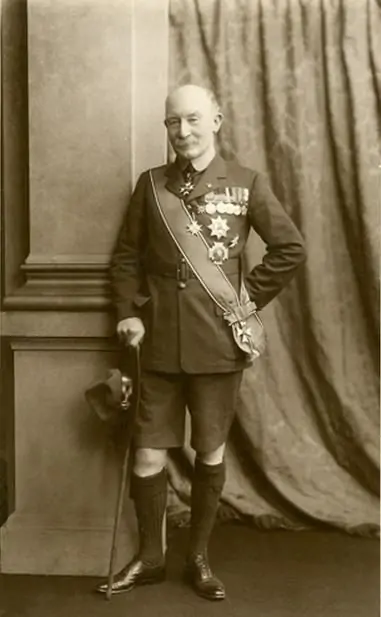
Submitted by Neil Duncan of the 8th Darlington (Cockerton Green) Scout Group.
Lieutenant-General Robert Stephenson Smyth Baden-Powell, 1st Baron Baden-Powell, OM, GCMG, GCVO, KCB, DL was born in 1857 and had a long and illustrious military career, as well as having a profound impact on civilian life for generations of young people.
Baden-Powell spent most of his military service in India and Africa where he honed his Scouting skills and began writing training manuals which would later be the basis for the Scouting Movement from 1908. One of his most famous commands was during the Seige of Mafeking in 1899 when a small garrison held out for 277 days and a ‘Cadet Force’ was drawn up take over small but important jobs to allow the adults to fight. These Cadets gain an honourable mention in the opening chapter of Scouting For Boys.
He returned to England to take up a post as Inspector-General of Cavalry in 1903. From 1908-10 he was in command of the Northern Territorial Army. During this appointment, Baden-Powell selected the location of Catterick Garrison to replace Richmond Castle which was then the Headquarters of the Northumbrian Division. His plan was brought to fruition following the outbreak of the First World War. The original concept was for a temporary camp to accommodate 2 complete divisions, 40,000 single men in 2,000 huts.
On the outbreak of World War I in 1914, at the age of fifty-seven, Baden-Powell put himself at the disposal of the War Office. Lord Kitchener said: “he could lay his hand on several competent divisional generals but could find no one who could carry on the invaluable work of the Boy Scouts”.
Explore more memories from the ribbon
-
Wilfred Whitfield
Wilfred was born in March 1896 in Marske by the Sea near Redcar on the East coast. When he was young his family moved to Middlesbrough where his father worked in the steelworks. Wilfred was training as a draughtsman when war broke out. Wilfred was just 5’ 2’’ tall, an inch shorter that the regulation height. But due to the great manpower losses he eventually got his chance in early 1915 when recruitment standards were somewhat relaxed. He enlisted in the 4th Battalion. It was in November of 1916 in the latter stages of the Somme offensive that the work party that Wilfred had volunteered for came under fire. On his way back to his own lines he was caught by a shell explosion. He was taken to a hospital at Abbeville where his left arm was amputated. Back in England Wilfred had to adjust to life without a limb. He was classed as ‘incurably unemployable’ and found it impossible to get a job. He used his time to study employment law and became a ceaseless campaigner for better conditions of his fellow jobless war wounded. He would continue to do so even when after he eventually gained employment. He was instrumental in establishing one of the first branches of BLESMA (British Limbless Ex-Servicemen’s Association) in Teesside. He married Elsie and his daughter Sylvia was born in 1932. However, his fifty cigarettes a day habit for most of his life would take their toll. He died of lung cancer in…
-
Reginald Howes
Ruth Kendon came into the museum and told us the story of her father, Reginald Howes. Reginald Howes (1889-1977) attended the University of London Officer Training Corps (OTC) between 6 May 1915 and 20 July 1916 before being commissioned as a 2nd Lieutenant in the Yorkshire Regiment on 21 July 1916. He served with the 4th Battalion as temporary Adjutant and Intelligence Officer, and was wounded on 15 September 1916 at Kemmel, just south of Ypres. Ruth remembers him saying he was wounded on the day tanks were first used. Howes was awarded the Military Cross in March 1918, for “conspicuous gallantry and devotion to duty” on the Somme, during the Kaiserschlacht offensive and promoted to Captain the following month. He was taken prisoner on 27 May 1918 and released on 14 December 1918. Ruth kindly donated a number of items which belonged to her father to the museum for safekeeping.
-
Alfred W Salmon
Alfred was born around June 1882 at Thornaby near Stockton, the son of Thomas Salmon, a foreman brewer. Alfred would eventually become an assistant grocer at Leyburn. Here he courted Lizzie Chiltern. Lizzie’s brother James had joined the West Yorkshire Regiment and was killed in June 1917 aged 20. It would appear that they never married as Alfred’s attestation form, when he signed up, has him as unmarried. The 1911 census has Alfred living in Leyburn as a boarder to a widow Catherine Pearson, aged 70. He enlisted on the 8th April 1916 at Leyburn joining the 5th Battalion Yorkshire Regiment. By early 1917 Alfred had been wounded and was to spend the rest of 1917 and part of 1918 convalescing in England. He was discharged from the Army on the 15th April 1918, his rank being Lance Corporal. Alfred was now living in Waverley Terrace, Darlington. It was here that he died from pneumonia, exacerbated by his war wounds on the 16th February 1919 aged 36. Alfred was buried in Darlington West Cemetery.
